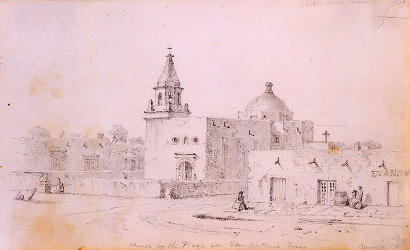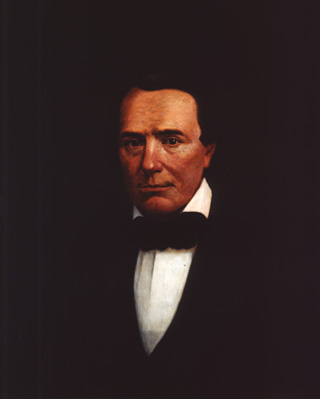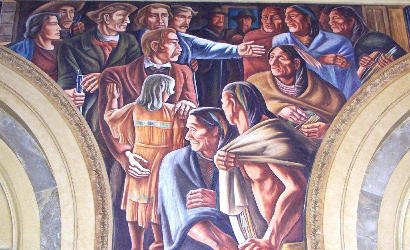|
Books by
Jeffery Robenalt
|
|
| In
March of 1840, a meeting took place in old San
Antonio between representatives of the government of the Republic
of Texas and the Penateka Comanches to discuss terms of a peace treaty.
The meeting was held in a small, one-story limestone building on the
corner of Main Plaza and Calabozo (Market) Streets know as the Council
House. The flat-roofed, earthen-floor structure adjoined the old stone
jailhouse where the City Hall now stands. The yard back of the Council
House was later the City Market. The disastrous results of this meeting
would soon lead to the
Great Comanche Raid of 1840 and the Battle of Plum Creek. |
 |
| Sam Houston,
the first president of Texas, had a policy of negotiating treaties
and territorial boundaries with the Republic's various Indian tribes,
including the Cherokees
and Comanches, believing that a peaceful settlement of disputes between
the races would lead to a permanent and inexpensive solution to the
Native American problem. However, this was an unpopular position with
many Texans, and Houston's successor in office, Mirabeau Lamar, was
elected in part by expressing an opposing view. Rather than negotiations,
Lamar insisted the only permanent solution to the Indian problem was
to expel the tribes from Texas, and to kill all those Indians who
refused to leave peacefully. |
 |
Immediately
after assuming the Presidency, Lamar moved to implement his policy
of expulsion or eradication with a vengeance. The first step was to
order Chief
Bowles to lead his Cherokees
out of Texas. When Bowles
refused as Lamar suspected he would, the President authorized militia
General Kelsey Douglass to use force to drive the Cherokees
out of the Republic.
On July 16, 1839, the militia, bolstered by a few soldiers from the
Texas Army, attacked the main Cherokee
village located on the Nueces
River. Chief
Bowles was among those killed during the fighting, and the Cherokees
were forced to hurriedly pack up a meager portion of their possessions
and move to present-day Oklahoma, leaving behind homes, livestock,
and crops ripening in the fields.
However, General Douglas refused to limit Lamarís policy to the Cherokees
alone, and by July 25, the militia had also driven the Caddo, Kickapoo,
Muskogee, Creek, Delaware, Shawnee, and Seminole tribes into Oklahoma
or across the Arkansas line. Only the small and inoffensive Alabama
and Coshatta tribes were permitted to remain inside the borders of
the Republic, and they were moved to less fertile lands on what was
to become one of the few permanent Texas Indian reservations.
President
Lamar hoped to quickly deal with the Comanches in a similar fashion.
Unfortunately, the fierce "Lords of the Plains" were a far cry from
the weak and nearly civilized tribes of east
Texas. The Penateka Comanches, the tribal band with territory
closest to white settlement, had been waging a continuous bloody hit
and run war for years with the settlers along the frontier north and
west of Austin.
President Lamar began his move against the Comanches by ordering his
newly formed companies of Texas Rangers to carry the fight into the
fringes of the Comancheria with attacks on hunting parties and a few
scattered villages such as Colonel John Moore's February, 1839, attack
on a Comanche village in the valley of the San
Saba River. Although these attacks on the basic way of Comanche
life were not always successful, they eventually convinced the Penateka
that the cost of continued fighting would carry a high price.
As a result, on January 9, 1840, several Penetaka war chiefs rode
into the old mission town of San
Antonio seeking a parley with the commander of the Texas Rangers,
Colonel Henry Karnes. At the meeting, the chiefs told Karnes all the
bands of the Penateka were ready to sit down with the whites and negotiate
a peace treaty. Karnes consented to the proposed meeting on the sole
condition that the Comanches return their white captives, believed
to have numbered around two hundred at the time. The war chiefs agreed
and promised to return to San
Antonio in twenty days.
Fearing the Comanches would fail to keep their promise, Colonel Karnes
wrote to General Albert Sidney Johnston, the commander of the Texas
Army, requesting that three peace commissioners be sent to San
Antonio, along with enough troops to capture the Indians who came
to the meeting and hold them as hostages if the white captives were
not returned. After conferring with President Lamar, Johnston agreed
and immediately dispatched three companies of the first regiment to
San Antonio under the
command of Lieutenant Colonel Fisher. Fisher was also appointed as
a peace commissioner along with the Texas Adjutant General and the
Acting Secretary of War. |
 |
San
Antonio post office mural depicting the Council House Fight
Photo courtesy Terry
Jeanson |
|
On
March 19, 1840, sixty-five Comanches, including men, women, and
children, boldly paraded into the streets of old San
Antonio. The brightly painted and attired contingent, dressed
in their finest and decorated with a rainbow of feathers and trade
ribbons, was led by twelve war chiefs and the great peace chief,
Muguara, or Muk-wah-rah, the Spirit Talker. Unfortunately, the Comanches
arrived for the meeting with only two captives; a sixteen year-old
girl, Matilda Lockhart, and a young Mexican boy the Texans didnít
even consider. To make matters worse, the young girlís condition
was abhorrent.
Matilda's face and body were covered with bruises and sores, and
the end of her nose had been burnt off down to the bone by malevolent
Comanche squaws who had routinely awakened her from sleep by sticking
a hot coal against her flesh, especially to the tip of her nose.
Matilda had lived with the Comanches for nearly two years and she
understood some of their language. She told the Texans the Comanches
had thirteen more captives in their camp, but they hoped to get
a higher price by returning them one at a time.
When Chief Muguara and the other war chiefs entered the Council
House, Muguara began the talks by demanding higher prices for the
remaining captives held by the Comanches. Ignoring the Peace chiefís
outrageous demands, the commissioners immediately insisted on knowing
why the other prisoners had not been returned as promised. Muguara
arrogantly answered that although they were being held by other
Comanche bands, they could all be purchased for the right price.
After seeing the mutilation of the young Lockhart girl, the commissioners
were furious, and Colonel Fisher ordered some of the soldiers who
had been surrounding the outside of the council house to enter the
meeting room. Next, a reluctant interpreter was ordered to tell
Muguara that he and the war chiefs would be imprisoned until the
remainder of the white captives were released. After delivering
the threat, the frightened interpreter turned and fled from the
room. The Texas Sentinel of March 24, 1840, provided a detailed
account of "a recent battle with the Comanches at San
Antonio."
Pandemonium ensued as the Comanches responded with shrill war cries
and rushed for the door. A war chief stabbed a soldier who attempted
to block the door with his body, and Fisher gave the command to
open fire. Muguara was killed instantly, and in the confusion caused
by echoing blasts of gunfire, howls and screams of the Comanches,
and thick clouds of swirling black powder smoke, the surviving Comanches
broke out of the building.
Even the young Comanche boys who had been playing outside during
the meeting joined in on the fight, firing arrows in all directions.
Indians, soldiers, and spectators alike were killed in the general
melee that followed, and in the end, none of the Comanches escaped
the deadly trap set by Colonel Fisher. Muguara and all twelve war
chiefs were killed along with many of the Comanche women and children.
About thirty women and children were taken prisoner. The Texans
suffered only six killed and ten wounded.
After
the smoke had settled, Colonel Fisher ordered that a squaw be given
a horse and sent to the Comanche camp with a warning; unless the
white captives were returned within twelve days all the Comanche
prisoners being held in the San
Antonio jail would be killed. The squaw never returned to San
Antonio, but eventually a young white boy who had been adopted
into the tribe told the terrible tale of what happened when the
war chiefís wife reached the camp.
The loss of so many warriors and leaders was a serious blow for
any Comanche band to suffer, and the Penateka went into a frenzy
of mourning. Women screamed and howled as they slashed at their
arms and legs with razor-sharp flint knives, and men sacrificed
many valuable horses to honor the brave dead. However, all this
was nothing compared with the ghastly fate suffered by the thirteen
white captives. Every one of them was either roasted alive or tortured
to death in hideous and lingering ways that only a fierce and vengeful
people like the Comanches could devise.
President Lamar's Indian policy and the ill-fated results of the
Council House fight ensured there would be no lasting peace between
the Republic of Texas and the Comanche nation, and for several months
after the incident people in and around San
Antonio lived in a state of terror. When nothing of note occurred
by mid-summer, the Texans assumed the Comanche threat was gone.
This assumption could not have been further from the truth. The
Penateka had simply melted away deep into the far northern reaches
of the Comancheria where they held council with all the other Comanche
bands. Under a brilliant August moon the Comanches would return
in a force heretofore unknown, and Texas would eventually pay a
terrible price in blood and suffering during the
Great Comanche Raid of 1840.
© Jeffery
Robenalt
"'A Glimpse of Texas Past"'
December
13, 2010 Column
jeffrobenalt@yahoo.com
See San Antonio
|
|
|
